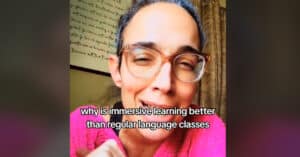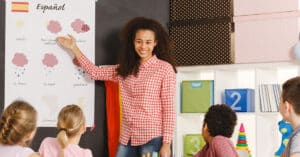If you want your kids to learn Spanish that’s actually useful, they must learn things they do in real life. Things that are common and part of their every day. That way they can practice their Spanish skills and everything they learn at school at any time of their life routine.
In fact, this month that’s exactly what we’re learning at TFK: daily routines and parts of the day, so we thought it’d be good to show this super useful topic we’ve been learning with our students. You can see how we teach through interesting methods and take this guide to help your own kids add this vocabulary into their days. Come with us!
Storytelling in Spanish
One of the ways we teach Spanish that’s entertaining for kids is storytelling. You probably know how much children love stories, whether through movies, fairy tales, cartoons or a good bedtime story. It’s not only fun, but also a good method for them to understand the world.
To add into that, it’s also a great technique for them to absorb a second language in a casual way.
Your kids probably already learned a lot of vocabulary for their mother tongue through stories. So why wouldn’t they do the same for their second language, right? It’s totally possible. This is because they’ll learn the words and phrases through a captivating context. Which means they’ll also learn how to use them in real life.
For this month’s topic, that’s exactly what we did. We presented the kids with an engaging story for them to acquire daily routines and parts of the day vocabulary. The story is split into four chapters: the morning, the afternoon, the night, and late at night – midnight.
The story is called “Good morning, Sol”. It follows the routines of the two main characters of our days: the Sun and the Moon! What do they do with their time? What are their favorite activities? What time do they wake up? When do they go to sleep?
Right now, we’re going to show you a bit of what we do in our classes for this topic. As well as explain to you why this is important to learn and how you can practice this vocabulary at home.
Class is Starting!
Wait! Before starting with the topic of the day, we ask our students some classic questions in Spanish. These are a must, as they’re very popular in Spanish and important to live a normal day in Spanish and hang out with natives. Here are some of those questions and answers for you to practice with your children.
- ¿Cómo te llamas tú? / What is your name?
- Me llamo… / My name is…
- ¿Cómo estás? / How are you?
- Estoy bien. / I’m good.
- Estoy cansado. / I’m tired.
- Estoy triste. / I’m sad.
- Estoy enojado. / I’m angry.
- ¿Te gusta estudiar español? / Do you like studying Spanish?
- Sí, me gusta. / Yes, I like it.
- No, no me gusta. / No, I don’t like it.
- ¿Tienes mascotas? / Do you have any pets?
- Sí, tengo un perro/gato. / Yes, I have a dog/cat.
- No, no tengo. / No, I don’t have one.
When your kids master those, you can ask other questions, such as:
- ¿Qué vas a hacer este fin de semana? / What are you going to do this weekend?
- Voy a… / I’m going to…
- ¿Cómo estabas ayer? / How were you yesterday?
- Estaba bien. / I was good.
- Estaba cansado. / I was tired.
- Estaba triste. / I was sad.
- Estaba enojado. / I was angry.
- ¿Has estudiado español esta semana? / Have you studied Spanish this week?
- Sí, he estudiado español. / Yes, I have studied Spanish.
- No, no he estudiado español. / No, I haven’t studied Spanish.
These are only some of the questions we ask children every day in class. If you enroll them in TruFluency Kids lessons, they’ll learn more.
Chapter 1: The Morning
It’s finally time for the storytelling. This is the first chapter: The morning.
We first recommend reading out loud and practicing some vocabulary for this chapter as a way of introducing your kids in the story. Some of the vocabulary for this part of the story is:
- La mañana comienza. / The morning begins.
- ¡Buenos días! / Good morning!
- Me despierto. / I wake up.
- Me lavo los dientes. / I brush my teeth.
After that, we read the story. Because it’s like we said, we can practice the words and phrases individually, one by one at first. But the best we can do is to learn them through context, so kids will acquire the vocabulary naturally. That’s exactly what we do at TruFluency Kids, we teach vocabulary through context.
Then, we recommend you ask some questions about the story to your kids, and they have to answer. All in Spanish. Here are some examples from our class:
- ¿Qué comienza? / What is about to begin?
- La mañana comienza. / The morning begins.
- ¿Qué hora es? / What time is it?
- Son las 7 / It’s seven.
- ¿Qué hace Sol? / What is Sol doing?
- Sol se lava los dientes. / Sol brushes her teeth.
Can you think of any other questions for your kids? Go ahead, ask them.
We also encourage you to ask your children about their own mornings. They can be yes or no questions, as in TFK that’s why we’ve been working on: Affirmatives and negatives. For example:
- ¿Desayunas en la mañana? / Do you have breakfast in the morning?
- Sí, desayuno en la mañana. / Yes, I have breakfast in the morning.
- No, no desayuno en la mañana. ¡Me duermo! / No, I don’t have breakfast in the morning. I sleep!
- ¿Estudias en la mañana? / Do you study in the morning?
- Sí, estudio en la mañana. / Yes, I study in the morning.
- No, no estudio en la mañana. ¡Me duermo! / No, I don’t study in the morning. I sleep!
So your kids keep on practicing with the story’s vocabulary but applied to their own lives, you can also ask them open questions about time in their routines. This is especially for kids from 7 to 12, as they might be more ready to answer this. For example:
- ¿Qué hora es? / What time is it?
- Son las ocho y media. / It’s 8:30.
- ¿A qué hora te despiertas? / At what time do you wake up?
- Me despierto a las nueve cuarenta y cinco. / I wake up at 9:45.
- ¿A qué hora te bañas en la mañana? / What time do you take a shower in the morning?
- En la mañana me baño a las… / In the morning I take a bath at…
Chapter 2: The Afternoon
Welcome to chapter two! Ready to read out loud the vocabulary as a way of practicing and getting into the chapter? Come on!
- La tarde comienza. / The afternoon begins.
- ¡Buenas tardes! / Good afternoon!
- Como / I have lunch.
- Hago la tarea. / I do homework.
- Juego. / I play.
- Estudio. / I study.
Now in class we read the chapter. You can do the same at home to see how those phrases are used within the story.
Just like with chapter first, let’s ask our kids some questions to see if they understood everything. This will also help them reinforce their knowledge by answering.
- ¿Qué comienza? / What is about to begin?
- La tarde comienza. / The afternoon begins.
- ¿Qué hora es? / What time is it?
- Son las 2. / It’s two.
- ¿Qué hace Sol? / What is Sol doing?
- Sol juega en el jardín. / Sol plays in the garden.
Just like before, now we can ask children yes and no questions about their afternoon routines.
- ¿Terminas la tarea en la tarde? / Do you finish homework in the afternoon?
- Sí, termino la tarea en la tarde. / Yes, I finish homework in the afternoon.
- ¿Juegas en la tarde? / Do you play in the afternoon?
- No, no juego en la tarde. / No, I don’t play in the afternoon.
For kids that are more grown up, around the ages of 7 to 12, you can ask them questions about days of the week. Include questions about their morning and afternoon routines, so they keep practicing what they’ve learned so far:
- ¿Qué día es hoy? / What day is today?
- Hoy es Lunes / Today is Monday.
- ¿Qué día estudias en la tarde? / What day do you study in the afternoon?
- Estudio en la tarde los… / I study in the afternoon on…
- ¿Qué día juegas en la mañana? / What day do you play in the morning?
- Juego en la mañana los… / I play in the morning on…
Chapter 3: The Evening
We’ve arrived at chapter three: The evening. Let’s see some of the vocabulary for this part of the “Good morning, Sol” story. Practice saying it out loud. You can add some gestures as you speak to remember it more easily.
- La noche comienza. / The night begins.
- ¡Buenas noches! / Good evening!
- Regreso. / I come back.
- Veo. / I see / I watch.
- Ceno. / I have dinner.
- Tengo sueño. Me voy a dormir. / I’m sleepy. I’m going to bed.
Great. Let’s read chapter three now to practice with some context. It’s cool, right?
Now we can ask some questions about the story to our kids. We do that in TFK classes, so they practice by answering in Spanish and see how their reading comprehension is doing. You can use some of the questions we used before for the morning and afternoon chapters. Or ask whatever comes to mind related to the story.
- ¿Qué comienza? / What is about to begin?
- La noche comienza. / The night begins.
- ¿Qué hace Sol? / What is Sol doing?
- Sol está en el jardín, pero regresa a casa. / Sol is in the garden, but comes back home.
- ¿Qué hace Luna? / What is Luna doing?
- Luna no se va a dormir. / Luna doesn’t go to bed.
- ¡Luna juega entre las estrellas! / Luna plays among the stars!
And now, one of the coolest activities, because it makes children part of the story. We ask them questions about their night routine, so they say affirmative or negative answers.
- ¿Ves la tele en la noche? / Do you watch TV at night?
- Sí, veo la tele en la noche. / Yes, I watch TV at night.
- ¿Cenas en la noche? / Do you have dinner at night?
- No, no ceno en la noche. / No, I don’t watch TV at night.
If your kids are older, around 7 to 12, you can also ask them about how often they do something. So they practice even more complicated vocabulary about daily routines. You can add evening time to these questions, so their practice keeps related to chapter three. For example:
- ¿Cada cuánto cenas pizza? / How often do you have pizza for dinner?
- Casi nunca ceno pizza. / I hardly ever have pizza for dinner.
For this type of “how often” questions we have this kind of answers:
- Siempre / Always
- Muy seguido / Very often
- A veces / Sometimes
- Casi nunca / Hardly ever
- Nunca / Never
Chapter 4: The Midnight
We’ve arrived at the final chapter: The midnight. Let’s read and act with gestures the vocabulary related to it:
- El día termina. / The day ends.
- Medianoche / Midnight
- Estoy dormido. / I’m sleeping.
- No tengo sueño. / I’m not sleepy.
- Tengo sueño. Me voy a dormir también. / I’m sleepy. I’m going to bed too.
And now, the questions about the story.
- ¿Qué termina? / What is about to end?
- El día termina. / The day ends.
- ¿Qué hora es? / What time is it?
- Son las diez. / It’s ten.
- ¿Qué hace Sol? / What is Sol doing?
- Sol está dormida. / Sol is asleep.
- ¿Qué hace Luna? / What is Luna doing?
- Luna va al espacio. / Luna goes to space.
You might feel like they’re similar or repetitive to questions made in past chapters. We always ask about what part of the day is ending or what the sun is doing. But that’s because we’re following the “Good morning, Sol” story. So questions are related to it.
Most importantly, repetition is key for learning vocabulary, acquiring the language, and strengthening the knowledge. The more your kids hear these questions and answer them (of course answers change depending on the part of the story), the more they’ll reinforce their Spanish.
Once again, we must involve the vocabulary we learned in the story in our kids’ life. So ask them about their personal night routines. For example:
- ¿Ves las estrellas en la noche? / Do you see the stars at night?
- No, no veo las estrellas en la noche. / No, I don’t see the stars at night.
- ¿Te vas a dormir en la medianoche? / Do you go to bed at midnight?
- Sí, me voy a dormir en la medianoche. / Yes, I go to bed at midnight.
If your children are around 7 to 12 years old, they’re ready to go further. Let’s teach them about organizing their schedule! It’s not only good vocabulary, but very useful too. This will work as a review of past chapters. Because you’ll use vocabulary learned above, such as “how often…?”, days of the week, and hours/times of the day. For example:
- ¿Qué tan seguido desayunas hot cakes? / How often do you have hot cakes for breakfast?
- A veces desayuno hot cakes. / Sometimes I have hot cakes for breakfast.
- ¿Qué día estudias en casa? / What day do you study at home?
- Estudio en casa de lunes a viernes. / I study at home from Monday to Friday.
- ¿A qué hora juegas? / At what time do you play?
- Juego a las cinco y media de la tarde. / I play at 5:30 in the afternoon.
There you go! Your kids have mastered the daily routines and parts of the day through storytelling and fun conversations. And with TKF, there’s more from where that came from.
Make TruFluency Kids Part of Your Routine
Do you know how else you can help your kids with their daily routines and part of the day practice? By adding our clases de español into their calendar. Sit down with your kids and make good use of what you just learned to pick a time of the day for them to attend our lessons. Ask them: “¿A qué hora quieres estudiar en TruFluency Kids?”
You won’t regret it; there’s so much more to learn. This is just a summary of the curriculum we send parents showing them what their kids are currently learning at TruFluency classes. But it’s not everything we teach and definitely not the only way we teach. We discuss many other Spanish topics with our students. We go from differences between “halla” and “allá” to setting the table in Spanish.
And we use different fun activities to help them develop in all areas of the language. We sing, play games, do crafts, cook, and encourage speaking to achieve fluency.
We’re aware you’re very busy and the whole family has a different agenda. Which makes it hard to drive from one place to another. Don’t worry, our lessons are completely online. So you won’t have to lose time in the traffic just to arrive at our language school.
If you need help making us part of your life routine, check our blog on how to use the calendar in Spanish.
You can also take a 30-minute trial class with a live native teacher. The classrooms have no more than five students, so it’s more personalized. And parents can have a Q & A after the class to answer any other doubt you may have. Our trial classes are now $9 for a limited time. So hurry up, catch the offer and make us part of your life!





